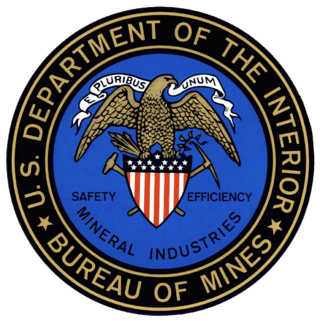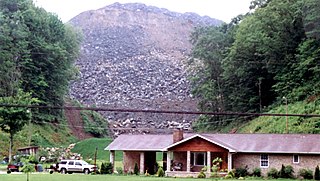Related Research Articles

The Environmental Protection Agency (EPA) is an independent agency of the United States government tasked with environmental protection matters. President Richard Nixon proposed the establishment of EPA on July 9, 1970; it began operation on December 2, 1970, after Nixon signed an executive order. The order establishing the EPA was ratified by committee hearings in the House and Senate.

The Occupational Safety and Health Act of 1970 is a US labor law governing the federal law of occupational health and safety in the private sector and federal government in the United States. It was enacted by Congress in 1970 and was signed by President Richard Nixon on December 29, 1970. Its main goal is to ensure that employers provide employees with an environment free from recognized hazards, such as exposure to toxic chemicals, excessive noise levels, mechanical dangers, heat or cold stress, or unsanitary conditions. The Act created the Occupational Safety and Health Administration (OSHA) and the National Institute for Occupational Safety and Health (NIOSH).
Earthjustice is a nonprofit public interest organization based in the United States dedicated to litigating environmental issues. Headquartered in San Francisco, they have an international program, a communications team, and a policy and legislation team in Washington, D.C., along with 14 regional offices across the United States.

The Resource Conservation and Recovery Act (RCRA), enacted in 1976, is the principal federal law in the United States governing the disposal of solid waste and hazardous waste.

Mountaintop removal mining (MTR), also known as mountaintop mining (MTM), is a form of surface mining at the summit or summit ridge of a mountain. Coal seams are extracted from a mountain by removing the land, or overburden, above the seams. This process is considered to be safer compared to underground mining because the coal seams are accessed from above instead of underground. In the United States, this method of coal mining is conducted in the Appalachian Mountains in the eastern United States. Explosives are used to remove up to 400 vertical feet of mountain to expose underlying coal seams. Excess rock and soil is dumped into nearby valleys, in what are called "holler fills" or "valley fills".

Surface mining, including strip mining, open-pit mining and mountaintop removal mining, is a broad category of mining in which soil and rock overlying the mineral deposit are removed, in contrast to underground mining, in which the overlying rock is left in place, and the mineral is removed through shafts or tunnels.

For most of the 20th century, the United States Bureau of Mines (USBM) was the primary United States government agency conducting scientific research and disseminating information on the extraction, processing, use, and conservation of mineral resources. The Bureau was abolished in 1996.

The Mine Safety and Health Administration (MSHA) is a large agency of the United States Department of Labor which administers the provisions of the Federal Mine Safety and Health Act of 1977 to enforce compliance with mandatory safety and health standards as a means to eliminate fatal accidents, to reduce the frequency and severity of nonfatal accidents, to minimize health hazards, and to promote improved safety and health conditions in the nation's mines. MSHA carries out the mandates of the Mine Act at all mining and mineral processing operations in the United States, regardless of size, number of employees, commodity mined, or method of extraction. David Zatezalo was sworn in as Assistant Secretary of Labor for Mine Safety and Health, and head of MSHA, on November 30, 2017. He served until January 20, 2021. Jeannette Galanais served as Acting Assistant Secretary by President Joe Biden on February 1, 2021 until Christopher Williamson took office on April 11, 2022.

Massey Energy Company was a coal extractor in the United States with substantial operations in West Virginia, Kentucky and Virginia. By revenue, it was the fourth largest producer of coal in the United States and the largest coal producer in Central Appalachia. By coal production weight, it was the sixth largest producer of coal in the United States.
The National Mining Association (NMA) is a United States trade organization that lists itself as the voice of the mining industry in Washington, D.C. The NMA was formed in 1995, and has more than 250 corporate members.

The Federal Coal Mine Health and Safety Act of 1969, U.S. Public Law 91-173, generally referred to as the Coal Act, was passed by the 91st United States Congressional session and enacted into law by the 37th President of the United States Richard Nixon on December 30, 1969.
Environment, health and safety (EHS) is the set that studies and implements the practical aspects of protecting the environment and maintaining health and safety at occupation. In simple terms it is what organizations must do to make sure that their activities do not cause harm to anyone. Commonly, quality - quality assurance and quality control - is adjoined to form the company division known as HSQE.

Asbestos is a naturally occurring fibrous silicate mineral. There are six types, all of which are composed of long and thin fibrous crystals, each fibre being composed of many microscopic "fibrils" that can be released into the atmosphere by abrasion and other processes. Inhalation of asbestos fibres can lead to various dangerous lung conditions, including mesothelioma, asbestosis, and lung cancer. As a result of these health effects, asbestos is considered a serious health and safety hazard.
Mining in the United States has been active since the beginning of colonial times, but became a major industry in the 19th century with a number of new mineral discoveries causing a series of mining rushes. In 2015, the value of coal, metals, and industrial minerals mined in the United States was US$109.6 billion. 158,000 workers were directly employed by the mining industry.
American Mining Congress v. Mine Safety & Health Administration, 995 F.2d 1106 (1993) is a decision by the United States Court of Appeals for the District of Columbia Circuit concerning the issues of administrative law and agency oversight.
The Stream Protection Rule was a United States federal regulation issued by the Office of Surface Mining Reclamation and Enforcement that went into effect on January 19, 2017. These regulations implement Title V of the 1977 Surface Mining Control and Reclamation Act (SMCRA). The original regulations had been issued in 1979 and were updated in 1983. Litigation over mountaintop removal mining required changes to the regulations, which were issued in 2008. These regulations were in turn struck down by a judge after litigation by environmental groups. The new regulations, the Stream Protection Rule, were issued in January 2017.
Fossil fuel regulations are part of the energy policy in the United States and have gained major significance with the nation's strong dependence on fossil fuel-based energy. Regulatory processes are established at the federal and state level due to the immense economic, socio-political and environmental impact of fossil fuel extraction and production. Over 80% of the United States' energy comes from fossil fuels such as coal, natural gas, and oil. The Bush administration was marked by the Energy Policy Act of 2005, which provided a monetary incentive for renewable energy adoption and addressed the issue of climate change. The Obama administration was made up of advocates for renewable energy and natural gas, while Donald Trump built his campaign on promises to revive the coal industry.

Environmental justice and coal mining in Appalachia is the study of environmental justice – the interdisciplinary body of social science literature studying theories of the environment and justice; environmental laws, policies, and their implementations and enforcement; development and sustainability; and political ecology – in relation to coal mining in Appalachia.

Environmental issues in Appalachia, a cultural region in the Eastern United States, include long term and ongoing environmental impact from human activity, and specific incidents of environmental harm such as environmental disasters related to mining. A mountainous area with significant coal deposits, many environmental issues in the region are related to coal and gas extraction. Some extraction practices, particularly surface mining, have met significant resistance locally and at times have received international attention.

David George Zatezalo is an American coal industry executive who served as the Assistant Secretary of Labor for Mine Safety and Health in President Donald Trump's administration, where he headed the Mine Safety and Health Administration.
References
- ↑ Declarations of policy of the American Mining Congress, NC946. Special Collections, University Libraries, University of Nevada, Reno
- ↑ Kellow, Aynsley and Simms, Marian. (2022). Mining Industry Association at Multiple Levels of Governance: Drilling Down. Cambridge Scholars Publishing, p. 38. ISBN 1.5275-7691-4.
- ↑ Graebner, William; Coal-Mining Safety in the Progressive Period: The Political Economy of Reform; University Press of Kentucky, Oct 21, 2021;
- ↑ Bakken, Gordon. (2008). The Mining Law of 1872: Past, Politics, and Prospects. University of New Mexico Press, p. 30. ISBN 978-08263-4357-4
- ↑ Ness, Immanuel. (2000). Encyclopedia of Interest Groups and Lobbyists in the United States. Routledge, p. 335. ISBN 0-7656-8022-X.
- 1 2 3 Glenn, Brian and Teles, Steven. (2009). Conservatism and American Political Development. Oxford University Press, p. 143. ISBN 978-0-19-537392-9
- ↑ Fraas, Elizabeth. (2006). The Public Papers of Governor Martha Layne Collins, 1983-1987. The University of Kentucky Press, P. 417. ISBN 978-0-8131-0608-3
- ↑ OPPOSITION VOICED ON WILDERNESS BILL; New York Times;
- ↑ Garrett, Theodore L.; Association, American Bar (2004). The RCRA Practice Manual. American Bar Association. p. 39. ISBN 1-59031-288-0.
- ↑ Circuit, District of Columbia (10 November 1992). "995 F2d 1106 American Mining Congress v. Mine Safety & Health Administration US American Mining Congress". p. 1106.
- ↑ Text of American Mining Congress v. Mine Safety & Health Administration, 995 F.2d 1106 (1993) is available from: CourtListener Google Scholar Justia OpenJurist